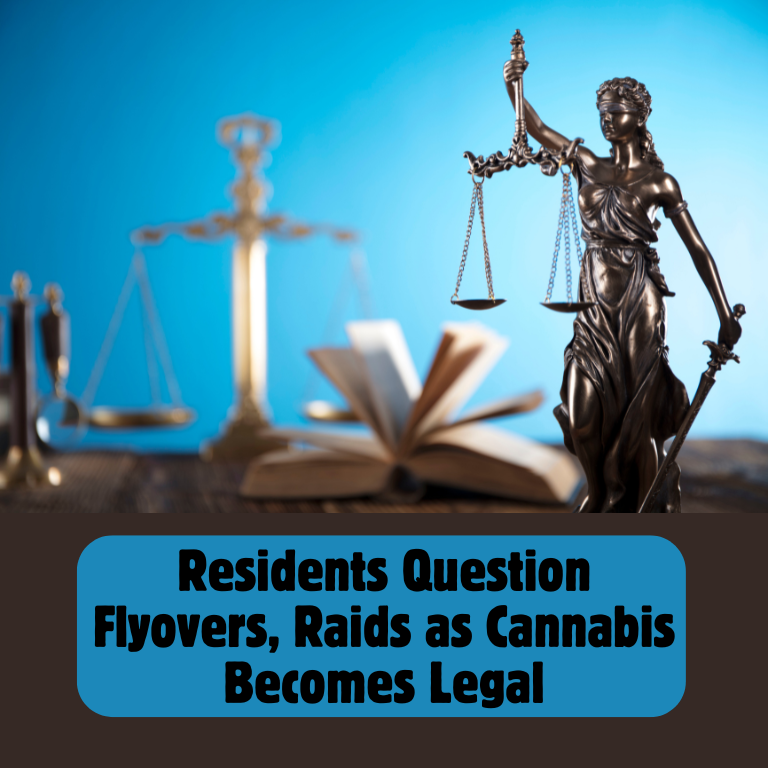Residents Question Flyovers, Raids as Cannabis Becomes Legal

Ohio Cannabis Growers Call for Clearer Laws Following Raids During Flyover Operation
Several Greene County residents whose properties were raided during a cannabis flyover operation in August are calling for clearer laws regarding home cannabis cultivation. They argue that both law enforcement officers and citizens need better guidance on what is and isn’t legal under Ohio’s home-grow laws.
Raids Target Home Growers
Chris Thompson, a property owner in the Fairborn area, was one of the Ohioans whose home was visited by law enforcement as part of a flyover operation conducted by the Agencies for Combined Enforcement (ACE) Task Force and the Ohio Bureau of Criminal Investigation (BCI). On August 13, Thompson noticed a helicopter hovering over his property before being visited by dozens of officers.
“(Officers) showed up and told me they were here to educate. I asked, you need 30 people to educate us?” Thompson recounted to Dayton Daily News.
Thompson, who was growing eight cannabis plants — within the legal limit for his household — was told that the plants appeared to be 25 from the air. The officers did not confiscate his plants, but the experience left him shaken and questioning how well law enforcement understood the law.
Annual Cannabis Eradication Effort
According to ACE Task Force records, the flyover was part of an annual marijuana eradication effort. This operation was potentially the first since home-growing became legal in Ohio last year. Some of the raids resulted in the seizure of marijuana plants, but in cases like Thompson’s and another in Yellow Springs, no plants were taken, though the aggressive approach by law enforcement raised concerns among property owners.
In Yellow Springs, property owners Mijanou and Kyle Lewis faced a similar experience. With a dozen legal cannabis plants on their property, they were also visited by a team of officers who reportedly told them they counted 40 plants from the air. Mijanou Lewis, whose husband is a horticulturist, expressed frustration, telling Yellow Springs News that the officers seemed unable to distinguish between cannabis and other plants.
“They didn’t know the difference between swamp hibiscus and marijuana,” she said.
Confusion Over Legal Requirements
Ohio’s cannabis home-grow law, passed in 2022, allows adults over 21 to grow six to twelve plants, depending on household size. These plants must be contained in a secured, enclosed area that prevents access by minors and is not visible from public spaces. However, the lack of clarity on what constitutes an “enclosed” space is causing confusion among both citizens and law enforcement.
Thompson kept his plants in a tall, fenced outdoor enclosure, intended to keep in large dogs like German Shepherds. While this seemed secure to him, officers told him the enclosure wasn’t sufficient because it lacked a roof, potentially allowing access to the plants.
“I thought it was safe, secured, and enclosed. If a German Shepherd can’t get through it, what more do you need?” Thompson asked.
Sheriff Scott Anger, whose office participated in the flyover, confirmed that the raids are a regular part of the task force’s operations. The goal, he said, is to ensure that individuals are complying with the law.
“If people are outside the scope of the law, our job is to help them get back in the right direction,” Anger said, noting that the focus is on preventing youth access to cannabis.
Calls for Clearer Legislation
Sheriff Anger acknowledged that the cannabis law is still new in Ohio and that law enforcement, too, could benefit from clearer guidelines. He said that many in law enforcement had hoped state lawmakers would clarify key aspects of the law after legalization took effect, but no such revisions have been made to date.
“With every right you have a responsibility,” Anger said. “But can ‘enclosed’ be defined much better? Absolutely.”
While no citations were issued to property owners like Thompson who were growing within the legal limits, the experience has left many feeling uneasy about future interactions with law enforcement. Thompson, who has since added a roof to his enclosure, is still questioning the need for such heavy-handed tactics.
Impact on Home Growers
The recent flyover operations have left many Ohioans wary about growing cannabis at home. While Thompson and the Lewises did not have their plants confiscated, the invasiveness of the raids has raised questions about whether law enforcement actions are aligned with the law’s intent.
Thompson emphasized that while he understands the importance of preventing minors from accessing cannabis, the operation did not feel like an educational effort. Instead, it left him anxious and afraid.
“There has to be a better way to educate people than this,” he said, adding that he had requested written guidance on how to properly secure his plants but never received any.
A Need for Legal Clarification
As Ohioans continue to adjust to the state’s new cannabis laws, both growers and law enforcement are calling for clearer guidelines. Sheriff Anger and others in law enforcement hope the legislature will provide more explicit definitions for terms like “enclosed” to prevent future confusion. In the meantime, growers like Thompson are left navigating the murky waters of compliance.
With raids like those in Greene County likely to continue, clearer communication between lawmakers, law enforcement, and citizens will be essential to ensuring that Ohio’s cannabis laws are followed without unnecessary confrontation or fear.











